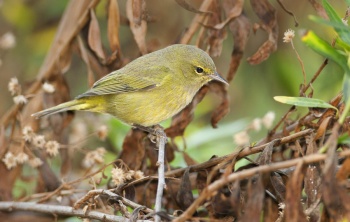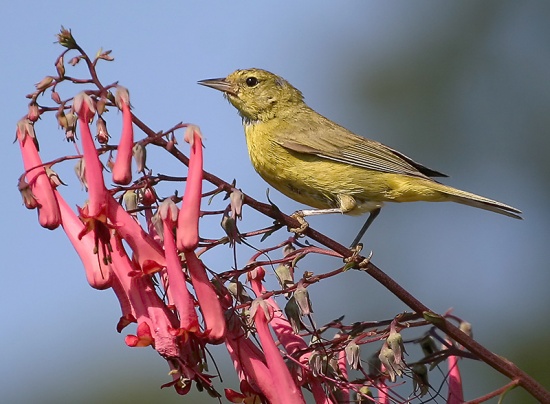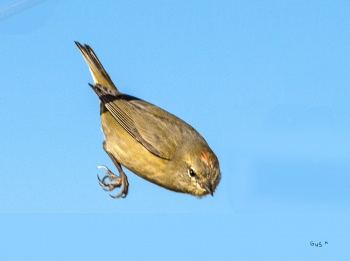m |
m (Text replacement - "<flashmp3>(.*)<\/flashmp3><br \/>" to "{{ Audio|$1 }}") |
||
| (22 intermediate revisions by 10 users not shown) | |||
| Line 1: | Line 1: | ||
| − | + | [[Image:Orange-crowned_Warbler.jpg|thumb|550px|right|Photo © by {{user|janruss|janruss}} <br />Edmonds, [[Washington]], [[USA]], 4 August 2005]] | |
| − | [[Image:Orange-crowned_Warbler.jpg|thumb| | + | ;[[:Category:Leiothlypis|Leiothlypis]] celata |
| − | + | ''Vermivora celata''<br /> | |
| − | + | ''Oreothlypis celata'' | |
==Identification== | ==Identification== | ||
| − | + | [[Image:Orangcrwnwarb MG 0011-Edit.jpg|thumb|350px|right|Subspecies ''lutescens'', winter adult<br />Photo © by {{user|digishooter|digishooter}}<br />Hart Park, Kern County, [[California]], [[USA]], November 2011]] | |
| + | 13 cm (5 inches)<br /> | ||
| + | Small, active, insect-eating bird with thin, very pointed bill. Indistinct yellow supercilium. Indistinct broken eye ring. Grayish to olive head, bac, and wings. No wing bars. Yellow to dull yellow/olive underparts with blurry, indistinct streaks on breast. Yellow undertail coverts. Orange crown rarely shows; most visible when crown feathers are raised, and from behind.<br /> | ||
| + | '''Females''' and immatures are somewhat duller. | ||
| + | ====Variations==== | ||
| + | Considerable variation in plumage with western birds being somewhat yellower and eastern birds grayer. | ||
| + | ==Distribution== | ||
| + | [[Alaska]] and almost universal in [[Canada]] (absent only in the southeast and far northeast); Western [[United States]] from [[Washington]] to western [[Montana]] south to [[California]] to western tip of [[Texas]]. | ||
| + | In migration found almost anywhere in the [[United States]] but far more widespread in west. | ||
| + | |||
| + | ==Taxonomy== | ||
| + | [[Image:P2251860-OCW-Orange-Pena.jpg|thumb|350px|right|Photo © by {{user|UncleGus_24|UncleGus_24}}<br />Green Valley, [[Arizona]], 25 February 2012]] | ||
| + | It was formerly included in ''[[:Category:Vermivora|Vermivora]]'' and ''[[:Category:Oreothlypis|Oreothlypis]]''. | ||
| + | ====Subspecies==== | ||
| + | There are 4 subspecies<sup>[[#References|[1]]]</sup>: | ||
| + | |||
| + | *''L. c. celata'': | ||
| + | :*Central [[Alaska]] to southern [[Canada]]; winters to [[Guatemala]] and [[Bahamas]] | ||
| + | *''L. c. orestera'': | ||
| + | :*Rocky Mountains to south-western [[US]] and western [[Texas]]; winters to ssouthern [[Mexico]] | ||
| + | *''L. c. lutescens'' | ||
| + | :*South-eastern Alaska to [[British Columbia]] and southern [[California]]; winters to [[Guatemala]] | ||
| + | *''L. sordida'': | ||
| + | :*Coastal southern California and islands off south-western California and [[Baja California]] | ||
| + | |||
| + | ==Habitat== | ||
| + | Marshes, suburban gardens, semi-wooded areas, oak savannah, riparian, open grass beside rivers and ponds. | ||
| + | ==Behaviour== | ||
| + | ====Diet==== | ||
| + | Their diet consists mostly of insects and spiders during the summer months, switching to berries and fruit in the winter. | ||
| + | Very active feeders in low shrubs, sometimes hovering. | ||
| + | ====Breeding==== | ||
| + | The female chooses the nest site, which is usually on the ground under dense vegetation, but may be in a shrub, low tree, fern, or vine. The nest is an open cup formed from grasses, shredded bark and moss, lined with fine grass and hair. The clutch consists of 4 to 5 eggs which are incubated for 11 to 13 days. Both parents feed the young. | ||
| + | ====Vocalisations==== | ||
| + | Song a variable trill, usually dropping in pitch and volume towards end. Usual call a hard, sharp, "tick." | ||
| + | :<br /> | ||
| + | {{ Audio|Orange-crownedWarbler.mp3 }} | ||
| + | [[Media:Orange-crownedWarbler.mp3|Listen to a song clip (subspecies ''L. c. lutescens'')]]<br /> | ||
| + | Recording © by {{user|jmorlan|Joseph Morlan}}<br /> | ||
| + | Pacifica, [[California]], 01 April 2020 | ||
| + | |||
| + | ==References== | ||
| + | #{{Ref-Clements6thAug19}}#Curson, J. (2020). Orange-crowned Warbler (''Leiothlypis celata''). In: del Hoyo, J., Elliott, A., Sargatal, J., Christie, D.A. & de Juana, E. (eds.). Handbook of the Birds of the World Alive. Lynx Edicions, Barcelona. (retrieved from https://www.hbw.com/node/61457 on 9 April 2020). | ||
| + | #BirdForum member observations | ||
| + | #Cornell Lab of Ornithology. 2019. Orange-crowned Warbler in: All About Birds. Cornell Lab of Ornithology, Ithaca, New York. https://www.allaboutbirds.org/guide/Orange-crowned_Warbler Accessed on 8 April 2020. | ||
| + | #Gilbert, W. M., M. K. Sogge, and C. van Riper (2020). Orange-crowned Warbler (''Leiothlypis celata''), version 1.0. In Birds of the World (P. G. Rodewald, Editor). Cornell Lab of Ornithology, Ithaca, NY, USA. https://doi.org/10.2173/bow.orcwar.01 | ||
| + | #R. T. Chesser, K. J. Burns, C. Cicero, et al. (2019) Sixtieth Supplement to the American Ornithological Society’s Check-list of North American Birds, The Auk: Ornithological Advances XX:1–23. PDF | ||
| + | {{ref}} | ||
| + | |||
==External Links== | ==External Links== | ||
| − | + | {{GSearch|Warbler+celata}} | |
| − | [[Category: | + | <br /> |
| + | {{Video|Orange_crowned_Warbler}} | ||
| + | |||
| + | [[Category:Birds]] [[Category:Vermivora]] [[Category:Oreothlypis]] [[Category:Leiothlypis]] [[Category:Videos]] | ||
Revision as of 16:19, 17 January 2021
- Leiothlypis celata
Vermivora celata
Oreothlypis celata
Identification

Photo © by digishooter
Hart Park, Kern County, California, USA, November 2011
13 cm (5 inches)
Small, active, insect-eating bird with thin, very pointed bill. Indistinct yellow supercilium. Indistinct broken eye ring. Grayish to olive head, bac, and wings. No wing bars. Yellow to dull yellow/olive underparts with blurry, indistinct streaks on breast. Yellow undertail coverts. Orange crown rarely shows; most visible when crown feathers are raised, and from behind.
Females and immatures are somewhat duller.
Variations
Considerable variation in plumage with western birds being somewhat yellower and eastern birds grayer.
Distribution
Alaska and almost universal in Canada (absent only in the southeast and far northeast); Western United States from Washington to western Montana south to California to western tip of Texas. In migration found almost anywhere in the United States but far more widespread in west.
Taxonomy
It was formerly included in Vermivora and Oreothlypis.
Subspecies
There are 4 subspecies[1]:
- L. c. celata:
- L. c. orestera:
- L. c. lutescens
- South-eastern Alaska to British Columbia and southern California; winters to Guatemala
- L. sordida:
- Coastal southern California and islands off south-western California and Baja California
Habitat
Marshes, suburban gardens, semi-wooded areas, oak savannah, riparian, open grass beside rivers and ponds.
Behaviour
Diet
Their diet consists mostly of insects and spiders during the summer months, switching to berries and fruit in the winter. Very active feeders in low shrubs, sometimes hovering.
Breeding
The female chooses the nest site, which is usually on the ground under dense vegetation, but may be in a shrub, low tree, fern, or vine. The nest is an open cup formed from grasses, shredded bark and moss, lined with fine grass and hair. The clutch consists of 4 to 5 eggs which are incubated for 11 to 13 days. Both parents feed the young.
Vocalisations
Song a variable trill, usually dropping in pitch and volume towards end. Usual call a hard, sharp, "tick."
Listen to a song clip (subspecies L. c. lutescens)
Recording © by Joseph Morlan
Pacifica, California, 01 April 2020
References
- Clements, J. F., T. S. Schulenberg, M. J. Iliff, S. M. Billerman, T. A. Fredericks, B. L. Sullivan, and C. L. Wood. 2019. The eBird/Clements Checklist of Birds of the World: v2019. Downloaded from http://www.birds.cornell.edu/clementschecklist/download/
- Curson, J. (2020). Orange-crowned Warbler (Leiothlypis celata). In: del Hoyo, J., Elliott, A., Sargatal, J., Christie, D.A. & de Juana, E. (eds.). Handbook of the Birds of the World Alive. Lynx Edicions, Barcelona. (retrieved from https://www.hbw.com/node/61457 on 9 April 2020).
- BirdForum member observations
- Cornell Lab of Ornithology. 2019. Orange-crowned Warbler in: All About Birds. Cornell Lab of Ornithology, Ithaca, New York. https://www.allaboutbirds.org/guide/Orange-crowned_Warbler Accessed on 8 April 2020.
- Gilbert, W. M., M. K. Sogge, and C. van Riper (2020). Orange-crowned Warbler (Leiothlypis celata), version 1.0. In Birds of the World (P. G. Rodewald, Editor). Cornell Lab of Ornithology, Ithaca, NY, USA. https://doi.org/10.2173/bow.orcwar.01
- R. T. Chesser, K. J. Burns, C. Cicero, et al. (2019) Sixtieth Supplement to the American Ornithological Society’s Check-list of North American Birds, The Auk: Ornithological Advances XX:1–23. PDF
Recommended Citation
- BirdForum Opus contributors. (2024) Orange-crowned Warbler. In: BirdForum, the forum for wild birds and birding. Retrieved 23 April 2024 from https://www.birdforum.net/opus/Orange-crowned_Warbler
External Links





